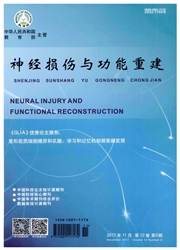

 中文摘要:
中文摘要:
目的:探讨选择性周期素依赖性蛋白激酶抑制剂Olomoucine对局灶性脑缺血后星形胶质细胞增殖及胶质疤痕形成的抑制作用。方法:将72只SD大鼠随机分为假手术组12只、模型组27只和干预组33只。3组均手术暴露颅骨,模型组和干预组建立光化学法诱导大鼠局灶性脑缺血模型,之后干预组腹腔注射Olomoucine,分别将3组大鼠于处理后3、7、30d处死,应用免疫组织化学法检测梗死灶周围胶质纤维酸性蛋白(GFAP)的表达;Western blot法观察损伤侧皮质GFAP、增殖细胞核抗原(PCNA)、周期素蛋白A(CyclinA)和周期素蛋白B1(CyclinB1)的表达。结果:缺血后各组梗死灶边缘区GFAP表达明显增强,缺血后7和30d模型组GFAP表达明显强于干预组(P〈0.05),并且7和30d对照组缺血边缘区可见胶质疤痕形成,尤以30d最为明显;GFAP、PCNA、CyclinA和CyclinB蛋白的表达,模型组明显高于干预组(P〈0.05)。结论:Olomoucine可部分抑制胶质细胞的活化增殖及疤痕的形成。该结果提示调控细胞周期可能是治疗脑缺血新的方向。
 英文摘要:
英文摘要:
Objective: The effect of a cell cycle inhibitor, olomoucine, on astrocytic proliferation was studied by measuring astrocytic proliferation and scar formation after focal cerebral ischemia in rats. Methods: An ischemic rat model was generated by photochemistry method. The expression of glial fibrillary acidic protein (GFAP) was studied by immunofluoreseence. Protein levels for GFAP, proliferation cell nuclear antigen (PCNA), cyclin A and cyclin B1 were investigated by Western blot at days 3, 7 and 30 after operation. Results: Olomoucine significantly reduced the expression of GFAP. In parallel study, glial scar tissue was observed near infarct regions in control rats at 7 and 30 days, and its density of scar formation was significantly greater at 30 days than at 7 days. Olomoucine significantly inhibited scar formation. Western blot showed increased protein levels for GFAP, PCNA, CyclinA and CyclinB1 in control rats, while the up-regulation of the proteins above was inhibited by olomoucine. Conclusion: The study suggested that olomoucine could significantly inhibit activation, proliferation and scar formation of astrocytes. Regulating cell cycles may provide a new method for treating cerebral ischemia.
 同期刊论文项目
同期刊论文项目
 同项目期刊论文
同项目期刊论文
 期刊信息
期刊信息
